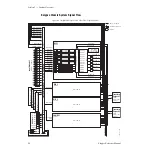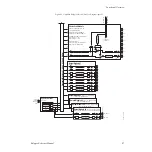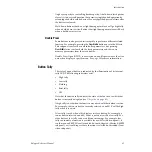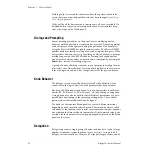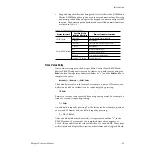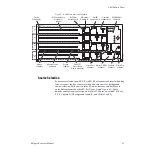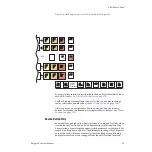
60
Kalypso Reference Manual
Section 2 — Control Panels
On some single press buttons, pressing the button again while the action is
being performed (the button will be lit) halts the action. The
Auto Trans
button is an example of a single press button that can be halted.
Alternate Action
Some system functions have two states, and are turned on and off by a
single alternate action button. Pressing the button when the function is off
turns the function on, and vice versa. The
Key Invert
button in the M/E Mod-
ifiers Keyers subpanel is an example of an alternate action button.
Interlocked Group
Many system functions have more than two states. Pressing a button in an
interlocked group sets the function to the state indicated by that button’s
label. Many of the Kalypso system interlocked groups are identified with
shaded lines on the panel behind the buttons in that group.
Source selector buttons on a bus are an example of one type of interlocked
group where selecting one button always turns off the previously selected
button. Only one of the sources can be selected on a source selection bus at
the same time.
In some cases, more than one function can be selected simultaneously in an
interlocked group. Holding down one button while pressing another
button in the group will activate both functions. Pressing only one button
in the group will turn off any other active functions in that group. If an indi-
vidual button is pressed when off, it will go on, and if pressed when on it
will stay on. The
Key 1 - 4
,
Bkgd
,
Triger
, and
Key Prior
buttons in the Transition
subpanel are an example of this type of interlocked group.
In some cases there are more states than buttons in an interlocked group.
For example, an additional “off” state may exist. In this case, pressing the
button that is lit selects the “off” state. Conceptually, this provides alternate
action for an interlocked group. Buttons in the Masks subpanel are an
example of this type of interlocked group. Only one of the
Wipe C 1
,
Wipe C 2
,
Keyer Wipe
,
Box
,
Utility Bus 1
, and
Utility Bus 2
buttons can be active at a time,
but masking can be turned entirely off by pressing the currently lit button.
In some special cases, an additional state may be selected by pressing pairs
of buttons in an interlocked group. For example, no button exists in the
Keyer subpanel for an adjustable linear keys. Pressing
Fixed Lin
and
Lum Key
simultaneously selects an adjustable linear key. Both button tallys will be
lit in this state.
Hold Down Modifiers
When held down, some buttons modify the normal behavior of other
buttons or knobs. For example, holding down the
Borderline
button in the
Keyers subpanel changes the delegation of the
Opacity
knob from control-











